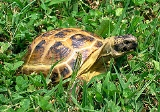
Russian Tortoise
Overview
The Russian tortoise, Horsfield's tortoise or Central Asian tortoise (Testudo horsfieldii, but see "Systematics" below) is a species
of tortoise
that is a popular pet
. It is named after the American naturalist Thomas Horsfield
.
The Russian tortoise is a small tortoise species, ranging from about 15 to 25 cm (6-8 inches for males, 8-10 inches for females). They are sexually dimorphic
in that the female
s grow slightly larger, male
s tend to have a longer tail
that is generally tucked to the side, and females tend to have flared scute
s on their shells, while males do not.
Species
In biology, a species is one of the basic units of biological classification and a taxonomic rank. A species is often defined as a group of organisms capable of interbreeding and producing fertile offspring. While in many cases this definition is adequate, more precise or differing measures are...
of tortoise
Tortoise
Tortoises are a family of land-dwelling reptiles of the order of turtles . Like their marine cousins, the sea turtles, tortoises are shielded from predators by a shell. The top part of the shell is the carapace, the underside is the plastron, and the two are connected by the bridge. The tortoise...
that is a popular pet
Pet
A pet is a household animal kept for companionship and a person's enjoyment, as opposed to wild animals or to livestock, laboratory animals, working animals or sport animals, which are kept for economic or productive reasons. The most popular pets are noted for their loyal or playful...
. It is named after the American naturalist Thomas Horsfield
Thomas Horsfield
Thomas Horsfield M. D. was an American physician and naturalist.Horsfield was born in Bethlehem, Pennsylvania, and studied medicine at the University of Pennsylvania. He was the grandson of Timothy Horsfield, Sr., a colonel and justice of the peace in Bethlehem, and a friend mentioned in Benjamin...
.
The Russian tortoise is a small tortoise species, ranging from about 15 to 25 cm (6-8 inches for males, 8-10 inches for females). They are sexually dimorphic
Sexual dimorphism
Sexual dimorphism is a phenotypic difference between males and females of the same species. Examples of such differences include differences in morphology, ornamentation, and behavior.-Examples:-Ornamentation / coloration:...
in that the female
Female
Female is the sex of an organism, or a part of an organism, which produces non-mobile ova .- Defining characteristics :The ova are defined as the larger gametes in a heterogamous reproduction system, while the smaller, usually motile gamete, the spermatozoon, is produced by the male...
s grow slightly larger, male
Male
Male refers to the biological sex of an organism, or part of an organism, which produces small mobile gametes, called spermatozoa. Each spermatozoon can fuse with a larger female gamete or ovum, in the process of fertilization...
s tend to have a longer tail
Tail
The tail is the section at the rear end of an animal's body; in general, the term refers to a distinct, flexible appendage to the torso. It is the part of the body that corresponds roughly to the sacrum and coccyx in mammals, reptiles, and birds...
that is generally tucked to the side, and females tend to have flared scute
Scute
A scute or scutum is a bony external plate or scale, as on the shell of a turtle, the skin of crocodilians, the feet of some birds or the anterior portion of the mesonotum in insects.-Properties:...
s on their shells, while males do not.
Unanswered Questions

